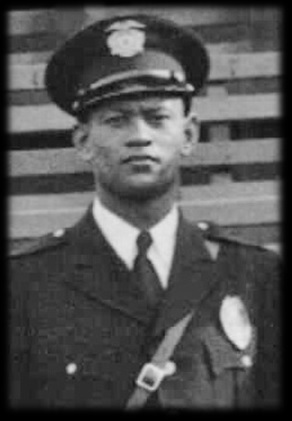Cops Come in Only One Color – Blue
Society isn’t colorblind. And while significant national achievements have been made since Dr. Martin Luther King Jr. declared, “I have a dream where one day a man will be measured not by the color of his skin but rather than the content of his character” this edition of the Crime Files celebrates Black History month by looking back at a long ago officer who served with distinction in an era of societal segregation, a separate Negro (baseball) League and a US military where Blacks could only hold jobs as cooks, stewards or other menial positions.
A star running back at San Diego High in the late 20’s - early 1930’s, William “Bert” Ritchey was ultimately awarded a football scholarship to USC only to find himself benched. When he questioned the coach he was told, “We’ve seen you play and we didn’t want to have to face you on the field if another school picked you.”
As ridiculous as it might sound today – to bench a star athlete simply because of the color of his skin – apparently it was an accepted tactic some 80 years ago. It was an ugly era.
With the Great Depression ravaging the economy, Bert graduated college with few employment prospects. He ultimately landed a job as a deputy sheriff however when Sheriff Cooper left office those loyal to him were fired.
Bert soon landed a job as a social worker, something once considered a career aspiration, but, in 1935, when he saw an opportunity for a better salary he applied with the San Diego Police Department.
After acing his interviews, Bert was handed his gold eagle top badge on May 25, 1935. His hiring made him only the 5th Black officer in the history of the Department. Officer Frank McCarter, Detective Reginald Townsend, Sergeant John Cloud and Officer Jasper Davis all predate him.
Like all new patrolmen, Bert began his career walking a beat.
He was about to learn a hard lesson that despite all cops wearing blue, some people fixate on the skin of the officer wearing it. Bert was outside the Ferris & Ferris drugstore when he was approached by a black teenager regarding a dispute with the owner. After listening to both sides, Bert’s decision to side with the youngster was greeted with a slew of racial slurs and threats.
The next day Bert was summoned by Chief George Sears where the department head shouted at him then unceremoniously transferred him to the Records and ID Bureau. The chief never asked for his side of the story.
The transfer turned out to be a blessing in disguise.
Bert took quickly to learning the science of fingerprints and photography. Soon, all the homicide detectives were requesting his assistance.
Later, his skills drew the attention of the head of the Homicide Bureau, Detective Lieutenant Ed Dieckmann a man widely considered to be one of California’s preeminent experts in investigations. Recognizing the value of forensics in criminal investigations, the bureau boss ordered Bert to be sent to every murder scene to handle the evidence.
In 1943, Clifford Peterson, a progressive chief who dreamed of remaking SDPD into a modern, professional police force was at the helm. By now Bert had developed such a reputation he was promoted from Patrolman to Detective Sergeant with a permanent stint in Homicide. It would be his final police assignment.
Despite the prestigious police assignment, Bert had his eye on bigger things and was heavily involved in the local community. In the 1940’s he served on a community commission that helped bring a YMCA to Southeastern San Diego.
In 1956, Bert began taking night courses at California Western School of Law. He received his law degree in 1961 but was still too young to retire. So he waited. Like many hopefuls, his first attempt at the bar exam fell short. His second attempt in 1963 was a success and even before he was notified of the results Bert announced his retirement.
His last day on the SDPD was Friday, March 29, 1964. Monday morning he received a letter from the California State Bar Association announcing he had successfully passed the test. Bert later recalled, “I had a client already, who had been waiting a couple of months, whom I had helped when I was on the police department. This lady had some trouble with her husband where he was charged with assault with a deadly weapon and I investigated the case. I had quite a bit of contact with her for several weeks there at that time, so some months later she said that she was going to get a divorce from him. She had heard I was studying law, and said she was going to wait until I got by the bar and could do her divorce.”
Shortly after reserving an office at 25th and Imperial, Bert received a call from retired Judge Alpha Montgomery asking if he’d like to work a private practice with him. Bert originally passed but reconsidered when Montgomery upped the offer to full partner. At the time there were less than five black attorneys in San Diego.
Bert and Montgomery ran a successful criminal defense practice for about 10 years. Along the way Bert was still involved in his community and, as a member of the Stadium Board in 1967, played a vital role in orchestrating the construction of ultimately became Qualcomm Stadium.
In his 1985 interview Bert offered a memorable experience: “I remember one time when there was a black feller arrested on a charge of rape and the report came into my office. I was on the homicide detail but they gave me any kind of a case; it could be homicide, rape, robbery, confidence games, if it involved a black. It was good for me because it was a more varied experience. Anyway, I got the report for this man who was arrested on a charge of rape. I went out to investigate the thing and talked to witnesses and came to find out he was the wrong guy. So when I come back to the station then I go in to talk to this feller. So I went in to the jailer, a white feller. Well, he was in the tank where this guy was sitting, and he was roughing him up and cussin' him. What are you doing? I said. I'm taking this man up to the office to talk to him, I said. Now, when he comes back here if he has any more problems, if you lay a hand on him, I said, I'm going straight to the chief of police. And, well, I of course told him a lot of other things too, that probably wouldn't be credible. So about an hour or two later, after I talked to the guy and brought him back, I released him; he was the wrong man.”
The Montgomery law firm became well known for its involvement in cases involving civil rights.
As a policeman and as an attorney, Bert Ritchey always said he looked forward to a day when America would be a place of racial equality and equal justice, working throughout his lifetime to achieve this goal.
Had he been born in a later era it may well be we would remember him as a great football running back. As it turned out, racial prejudice snuffed a promising career in sports. This prejudice, however, unintentionally funneled Ritchey’s talents into a career as a “Drum Major for Justice” – to coin Martin Luther King’s phrase – on the streets of San Diego.
Bert Ritchey died in 1995 however his legacy as a giant in policing, civil rights, justice and dignity, will live forever with those who knew him.



